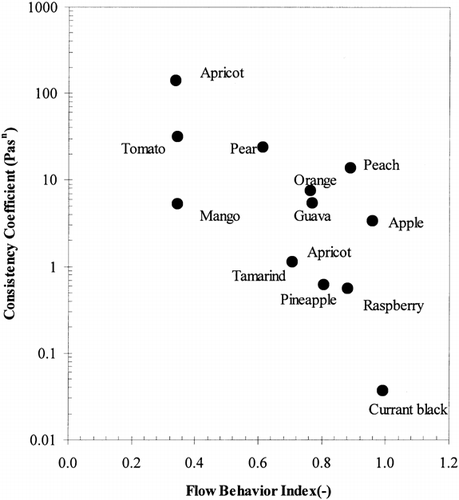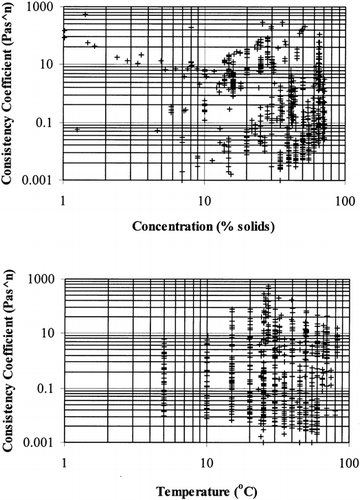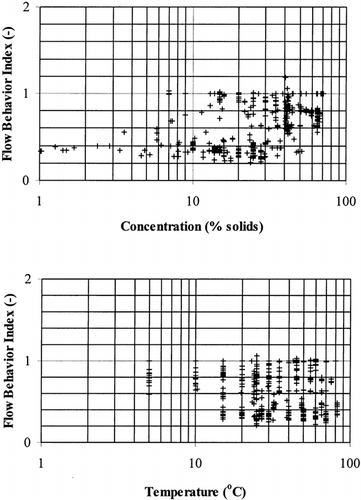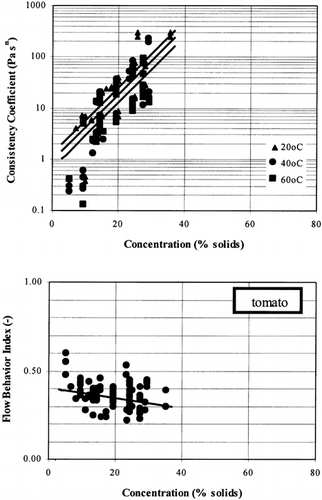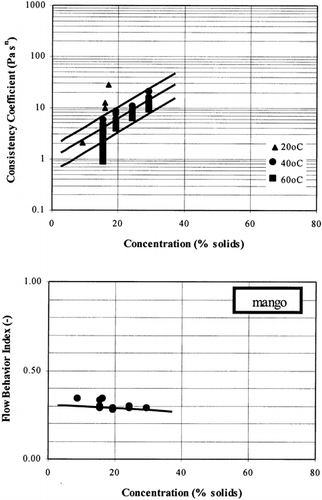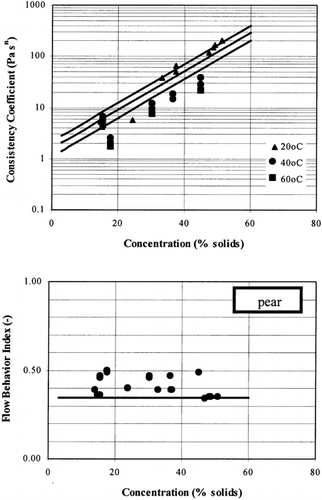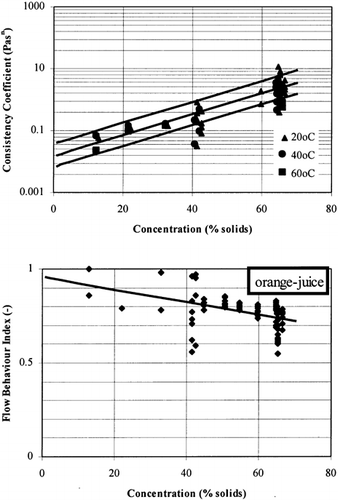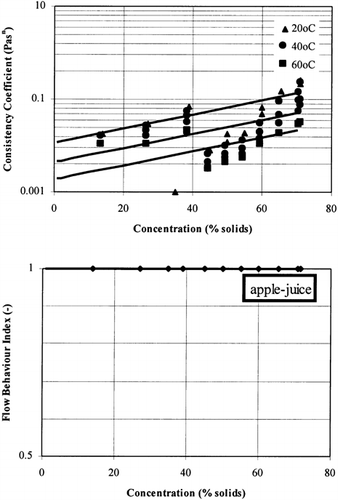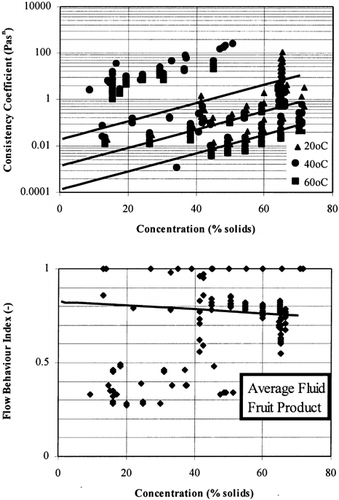Abstract
Recently published values of rheological properties of fluid fruit and vegetable puree products were retrieved from the literature and analyzed. The results of more than 10 materials are presented, concerning the reported ranges of variation of Consistency Coefficient and Flow Behavior Index, together with the corresponding ranges of variation of concentration and temperature. The related literature sources are presented for each material. Empirical models, relating both Consistency Coefficient and Flow Behavior Index to concentration and temperature, are proposed and fitted to all retrieved data for each material. The data were screened carefully, using residual analysis techniques.
INTRODUCTION
The viscosity of fluid foods is an important transport property, which is useful in many applications of Food Science and Technology, such as design of food processes and processing equipment, quality evaluation and control of food products, and understanding the structure of food materials. Due to the complex chemical and physical structure of foods, viscosity can not be predicted by theoretical methods, such as Molecular Dynamics, and semi-empirical models, applied to pure fluids. Therefore, experimental measurements and empirical models of viscosity are necessary for the characterization of fluid foods.
Viscosity is part of the wider rheological properties of foods, which cover, in addition to fluids, the solid and semisolid food materials. Foods, in general, can be classified as solids, gels, homogeneous liquids, suspensions in liquid, and emulsions Citation[48]. Fluid foods are heterogeneous materials, consisting of dispersions of fibers, cells, protein particles, oil droplets and air bubbles in a continuous phase, like an aqueous solution of sugars, or a vegetable oil.
Recent advances in the design and control of food processes, utilizing computer modeling and simulation, require extensive data on the physical and engineering properties of foods. Limited reliable data are available in the literature, particularly in the areas of rheological properties (viscosity) and mass diffusivity of food systems Citation52-54.
Food rheology deals with all the phenomena of deformation and flow of food materials due to external forces. Viscometry deals with fluids, which are characterized by mechanical flow, upon the application of an external force. The viscometric properties of fluid foods are discussed here in analogy to the two other basic transport properties, thermal conductivity Citation[26] and mass diffusivity Citation[27]. The rheological properties of solid and semisolid foods (elasticity and viscoelasticity) are discussed in specialized books Citation[7], Citation[48]. Most solid and semi-solid foods are not elastic, but they behave as either viscoelastic or viscoplastic.
The viscoelasticity of the materials is studied by stress relaxation measurements, i.e. shear stress at constant strain versus time Citation[48]. The viscoelastic behavior is characterized by Newton's law, Hooke's law, and Newton's second law. Most solid and semi-solid foods are considered linear viscoelastic, which allows the adding up of the three elements, i.e. the viscous, elastic, and inertial effects. Neglecting the inertial component, the viscous (dashpot) and the elastic (spring) effects are usually combined into two common models, i.e. the Newton (series model), and the Kelvin-Voigt (parallel model).
The rheological behavior of fluid foods is determined by measurements of shear stress versus shear rate, and representation of the experimental data by viscometric diagrams and empirical equations, as a function of temperature and/or concentration. Molecular Dynamics can not predict fluid viscosity, but it can be helpful in understanding the flow mechanism of complex fluid foods. Physical structure plays a decisive role in determining the fluid viscosity. Literature data of rheological properties of fluid foods are useful in design and handling applications. Such literature data for various liquid foods were selected and presented recently Citation[48].
The scope of this paper is (a) to update and analyze the above data concerning fluid fruit and vegetable puree products (b) to propose a mathematical model and calculate both the Consistency Coefficient and the Flow Behavior Index as a function of concentration and temperature, and (c) to fit the model simultaneously to all available literature data and obtain higher accuracy in estimation of rheological properties.
MATHEMATICAL MODEL
The fruit and vegetable juices/concentrates, are assumed to behave as non-Newtonian fluids, following the power-law model:
The Herschel-Bulkley model is derived from the power-law model by adding a yield stress term (τ o ):
Most non-Newtonian foods are pseudoplastic materials (n < 1), while very few are dilatant (n > 1). The pseudoplastic fluids are also known as shear-thinning fluids, since their apparent viscosity decreases as the shear rate is increased.
The power law and Herschel-Bulkley models have been used widely, and extensive rheological data for non-Newtonian fluid foods have been published in the literature Citation[41], Citation[37], Citation[24], Citation[60]. In pure liquids, the effect of temperature on viscosity follows the Arrhenius equation, which can be derived from the theory of rate processes. The same equation has been applied to the viscosity (η) of Newtonian of fluid foods, and to the consistency coefficient (K) of power-law (non-Newtonian) food materials Citation[48]:
In Newtonian fluid foods, the energy of activation has been found to increase from 14.4 kJ/mol (water) to more than 60 kJ/mol (concentrated clear juices and sugar solutions).
Temperature has a major effect on the consistency coefficient (K) of the non Newtonian fluid foods, analogous to the effect on Newtonian viscosity (η). The flow behavior index (n) is affected only slightly by temperature (a small increase at high temperatures). The energy of activation for flow in non-Newtonian fluids is significantly lower than the corresponding value for Newtonian fluids of the same solids concentration Citation[51]. In suspensions of fluid foods of high non-soluble solids concentration, like fruit or vegetable pulps, (E) may be lower than the activation energy for viscous flow of water (14.4 kJ/mol).
Concentration of soluble solids (oBrix) and insoluble solids (e.g. pulp) has a strong non-linear effect on the viscosity of Newtonian fluid foods, the consistency coefficient (K), and the apparent viscosity of non-Newtonian foods. Two similar exponential models, one for oBrix and a second for % pulp, were proposed by Vitali and Rao Citation62-63 for concentrated orange juice, of the general form:
The above equation is an Arrhenius-type model, where To is the reference temperature.
| Ko (Pa sn ) | = |
Reological constant of fluid food at concentration C = 0 and temperature T = To , |
| E (kJ/mol) | = |
Activation Energy for viscous flow in a fluid food at C = 0 |
The additive model assumes no temperature-solids concentration interaction. This may not be true when temperature affects the solids structure and particle size in the suspension, e.g. by hydrolysis of macromolecules, coagulation of colloids, and breakdown or buildup of agglomerates.
The energy of activation for viscous flow (Ea ) is estimated at a constant shear rate, usually at 100 (1/s) Citation[51], Citation[48]. However, the structure of some food suspensions of high particle (pulp) concentration may be changed due to this relatively high shear rate. For this reason, in such cases, a lower shear rate may be preferable. Prentice and Huber Citation[41] used a shear rate of 10 (1/s) in evaluating the effect of temperature on the rheology of apple sauce.
The flow behavior index n is assumed to be a linear function of concentration C and independent of temperature T, according to the equation:
REGRESSION ANALYSIS
The proposed model is fitted to data using a non linear regression analysis method. It is fitted to all literature data for each material and the estimates of the model parameters are obtained. Then the residuals (the differences between experimental and model calculated values) are examined and the data with larger than the 3x average residual are rejected. The procedure is repeated until the standard deviation between experimental and calculated values approaches the experimental error.
RESULTS AND DISCUSSION
A total number of more than 62 publications were retrieved from the literature. Table shows the related publications for every material. Table presents the range of variation of the Consistency Coefficient and the Flow Behavior Index for each material along with the corresponding ranges of moisture and temperature. The range of variation of each material is presented graphically in Figure . Moreover, the histogram in Figure reveals the distribution of the Consistency Coefficient and the Flow Behavior Index values retrieved from the literature. Average values of the Consistency Coefficient and the Flow Behavior Index for all the examined materials are presented in Figure .
Table 1. Literature for Viscosity Data of Fluid Food Materials
Table 2. Range of Shear Rate, K and n Values of Fluid Foods Versus Concentration, and Temperature
Figure 1. Histogram of variation of consistency coefficient and flow behaviour index in food materials.
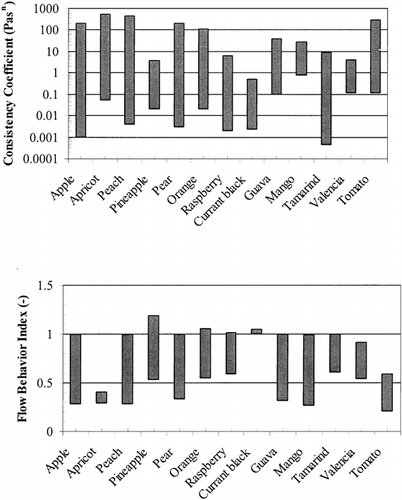
Figure 3. Histogram of observed values of consistency coefficient and flow behaviour index in food materials.
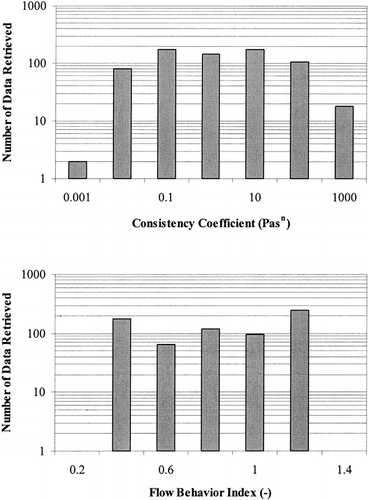
A total number of 707 data for the Consistency Coefficient and the Flow Behavior Index were obtained. The data of consistency coefficient and flow behavior index are plotted against concentration and temperature in Figures and , respectively. These figures show a good idea concerning the range of variation of Consistency Coefficient and the Flow Behavior Index, concentration and temperature values. The values of K and n varied from 0.001 to 1000 Pa sn and 0.2 to 1.0, respectively depending on temperature and concentration. Table shows the related publications for every food material. Table presents the range of variation for shear stress and the values of Consistency Coefficient and the Flow Behavior Index for each material. Table presents the range of variation and Table average values of the Consistency Coefficient and the Flow Behavior Index for each material, along with the corresponding ranges of concentration and temperature.
Table 3. K and n Values of Fluid Foods Versus Concentration and Temperature. Variation Range of Available Data
Table 4. K and n Average Values of Fluid Foods Versus Concentration and Temperature
Among the available data only 5 materials (tomato, pear, mango, orange and apple) have more than 10 different experimental points, which come from more than 3 publications. The procedure is applied to these data and the results of parameter estimation are presented in Table . In all cases τ o was statistically insignificant.
Table 5. Estimated Values of the Parameters of Consistency Coefficient and Flow Behavior Index
Figures present the retrieved data from the literature and the model calculated values for the above materials. The consistency coefficient (K) increases exponentially with the concentration, while the flow behavior index decreases slightly. Concentration has a stronger effect on (K) of tomato than the other four fruits probably due to lower sugar concentration. The higher activation energy for mango may be due to its higher sugar composition.
Temperature has a negative effect on the consistency coefficient (K), as shown from the significant positive values of the activation energy for flow (E). Pulpy products, like tomato concentrates, have lower (E) values, meaning that temperature has a smaller effect on (K) than in clear juices, e.g. apple.
Figure shows predicted values of the model for an “average” fruit-product, estimated by direct regression of all the experimental data of the four fruits.
It must be noted that the regression procedure was applied simultaneously to all the data of each material, regardless of the data sources. Thus, the results are not based on the data of only one author and consequently they are of higher reliability and general applicability.
CONCLUSIONS
Data concerning fluid fruit and vegetable products were updated and analyzed. A mathematical model was proposed to calculate both the Consistency Coefficient and the Flow Behavior Index as a function of concentration and temperature. It is evident that the consistency coefficient decreases with temperature and it increases with concentration of fluid food products, while the flow behavior index is close to 0.5 for pulpy products and near 1.0 for clear juices and it decreases slightly with concentration.
Acknowledgments
REFERENCES
- Alviar , M. , Salome , B. and Reid , D. S. 1990 . Determination of Rheological Behaviour of Tomato Concentrates Using Back Extrusion . Journal of Food Science , 55 : 554 – 555 .
- Autio , K. 1991 . Measurement of Flow Curves for Model Liquids and Real Food Systems with Two Commercial Viscometers . Journal of Food Engineering , 13 : 57 – 66 .
- Barbosa-Canovas , G. V. and Peleg , M. 1983 . Flow Parameters of Selected Commercial Semi-Liquid Products . Journal of Texture Studies , 14 : 213 – 234 .
- Benezech , T. and Maingonnat , J. F. 1993 . Flow Properties of Stirred Yoghurt: Structured Parameter Approach in Describing Time Dependency . Journal of Texture Studies , 24 : 455 – 473 .
- Bhattacharya , S. , Bal , S. , Mukherjee , R. K. and Battacharya , S. 1991 . Rheological Behaviour of Tamarind Tamarindus Indica Kernel Suspension . Journal of Food Engineering , 13 : 151 – 158 .
- Bianchi , M. A. , Pilosof , A. M.R. and Bartholomai , G. B. 1985 . Rheological Behaviour of Comminuted Meat Systems Containing Soy Protein Isolates . Journal of Texture Studies , 16 : 193 – 206 .
- Bourne , M. C. 1982 . Food Texture and Viscosity. Concept and Measurement New York : Academic Press .
- Brekke , J. E. and Myers , A. L. 1978 . Viscometric Behaviour of Guava Purees and Concentrates . Journal of Food Science , 43 : 272 – 273 .
- Cepeda , E. and Villaran , M. C. 1999 . Density and Viscosity of Malus Floribunda Juice as a Function of Concentration and Temperature . Journal of Food Engineering , 41 : 103 – 107 .
- Crandall , P. G. , Chen , C. S. and Carter , R. D. 1982 . Models for Predicting Viscosity of Orange Juice Concentrate . Food Technology , 36 ( 5 ) : 245 – 252 .
- Fang , T. N. , Tiu , C. , Wu , X. and Dong , S. 1996 . Rheological Behaviour of Cocoa Dispersions . Journal of Texture Studies , 26 : 203 – 215 .
- Fito , P. J. , Clemente , G. and Sanz , F. J. 1983 . Rheological Behaviour of Tomato Concentrates Hot and Cold Break . Journal of Food Engineering , 2 : 51 – 62 .
- Garcia , R. , Rivera , J. and Rolz , C. 1974 . Rheological Properties of Tropical Products and their Enzymic Classification . Procedures IV International Cong. of Food Science and Technology , 2 : 18 – 26 .
- Gunjal , B. B. and Waghmare , N. J. 1987 . Flow Characteristics of Pulp, Juice and Nectar of “Baneshan” and “Neelum” Mangoes . Journal of Food Science and Technology of India , 24 : 20 – 23 .
- Harper , J. C. and El-Sahrigi , A. F. 1965 . Viscometric Behaviour of Tomato Concentrates . Journal of Food Science , 30 : 470 – 476 .
- Harper , J. C. and Leberman , K. W. 1962 . Rheological Behaviour of Pear Purees . Proc. 1st International Cong. Of Food Science and Technology , 1 : 719 – 728 .
- Harper , J. C. 1960 . Viscometric Behaviour in Relation to Evaporation of Fruit Purees . Food Technology , 14 : 557 – 560 .
- Hayes , G. D. 1987 . Food Engineering Data Handbook New York : John Wiley & Sons .
- Hermandez , E. , Chen , C. S. and Carter , R. D. 1995 . Viscosity Changes in Orange Juices . Journal of Food Engineering , 25 : 387 – 396 .
- Ibarz , A. and Pagan , J. 1987 . Rheology of Raspberry Juices . Journal of Food Engineering , 6 : 269 – 289 .
- Ibarz , A. , Gonzales , C. , Esplugas , S. and Vicente , M. 1992 . Rheology of Clarified Juices. I: Peach Juices . Journal of Food Engineering , 15 : 49 – 61 .
- Ibarz , A. , Pagan , J. and Miguelsanz , R. 1992 . Rheology of Clarified Fruit Juices. II: Blackcurrant Juices . Journal of Food Engineering , 15 : 63 – 73 .
- Ibarz , A. , Vicente , M. and Graell , J. 1987 . Rheological Behaviour of Apple Juice and Pear Juice and Concentrates . Journal of Food Engineering , 6 : 257 – 267 .
- Kokini , J. L. 1992 . “ Rheological Properties of Food ” . In Handbook of Food Engineering Edited by: Heldman , D. R. and Lund , D. B. 1 – 38 . New York : Marcel Dekker .
- Krishna , A. G.G. 1993 . Influence of Viscosity on Wax Settling and Refining Loss in Rice Bran Oil . Journal of American Oil Chemistry Society , 70 : 895 – 898 .
- Krokida , M. K. , Panagiotou , N. M. , Maroulis , Z. B. and Saravacos , G. D. 2000a . Thermal conductivity: literature data compilation for foodstuffs . International Journal of Food Properties , (in print)
- Panagiotou , N. M. , Krokida , M. K. , Maroulis , Z. B. and Saravacos , G. D. 2000b . Moisture Diffusivity: Literature Data Compilation for Foodstuffs . International Journal of Food Properties , (in print)
- Lang , W. , Sokhansanj , S. and Sosulski , F. W. 1992 . Modelling the Temperature Dependence of Kinematic Viscosity for Refined Canola Oil . Journal of American Oil Chemistry Society , 69 : 1054 – 1055 .
- Lopez , A. , Ibarz , A. , Pagan , G. and Vilavella , M. 1989 . Rheology of Wine Musts during Fermentation . Journal of Food Engineering , 10 : 155 – 161 .
- Maesmans , G. , Hendrickx , M. , DeCordt , S. and Fransis , A. 1992 . Fluid-to-Particle Heat Transfer Coefficient Determination of Heterogeneous Foods: A Review . Journal of Food Processing and Preservation , 16 : 29 – 69 .
- Manohar , B. , Ramakrishna , P. and Udayashankar , K. 1991a . Some Physical Properties of Mango Pulp Concentrate . Journal of Texture Studies , 21 : 179 – 190 .
- Manohar , B. , Ramakrishna , P. and Udayashankar , K. 1991b . Some Physical Properties of Tamarind Tamarindus Indica L. Juice Concentrates . Journal of Food Engineering , 13 : 241 – 258 .
- McCarthy , K. L. and Seymour , J. D. 1994 . A Fundamental Approach for the Relationship Between the Bostwick Measurement and Newtonian Fluid Viscosity . Journal of Texture Studies , 24 : 1 – 10 .
- Mizrahi , S. 1979 . A Review of the Physicochemical Approach to the Analysis of the Structural Viscosity of Fluid Food Products . Journal of Texture Studies , 10 : 67 – 82 .
- Munro , J. A. 1943 . The Viscosity and Thixotropy of Honey . J. Econ. Entomol. , 36 : 769 – 777 .
- Noureddini , H. , Teoh , B. C. and Clements , L. D. 1992 . Viscosities of Vegetable Oils and Fatty Acids . Journal of American Oil Chemistry Society , 69 : 1189 – 1191 .
- Okos , M. R. Physical and Chemical Properties of Food . American Society of Agricultural Engineers ,
- Perez , M. G.R. and Calvelo , A. 1986 . 1984. Modeling the Thermal Conductivity of Cooked Meat . Journal of Food Science , 49 : 152 – 156 .
- Paredes , M. D.C. , Rao , M. A. and Bourne , M. C. 1989 . Rheological Characterization of Salad Dressings. 2. Effect of Storage . Journal of Texture Studies , 20 : 235 – 250 .
- Perry , J. H. and Green , D. 1997 . Chemical Engineer's Handbook , 7th Ed. New York : McGraw-Hill .
- Prentice , J. H. and Huber , D. 1983 . “ Results of the Collaborative Study on Measuring Rheological Properties of Foodstuffs ” . In Physical Properties of Foods
- Qiu , C-G. and Rao , M. A. 1988 . Role of Pulp Content and Particle Size in Yield Stress of Apple Sause . Journal of Food Science , 53 : 1165 – 1170 .
- Ramaswamy , H. S. and Basak , S. 1991 . Rheology of Stirred Yoghurts . Journal of Texture Studies , 22 : 231 – 241 .
- Rao , K. L. , Eipeson , W. E. , Rao , P. N.S. , Patwardhan , M. V. and Ramanathan , P. K. 1985 . Rheological Properties of Mango Pulp and Concentrate . Journal of Food Science and Technology of India , 22 : 30 – 33 .
- Rao , M. A. and Cooley , H. J. 1992 . Rheology of Tomato Pastes in Steady and Dynamic Shear . Journal of Texture Studies , 23 : 415 – 425 .
- Rao , M. A. 1977 . Rheology of Liquid Foods-A Review . Journal of Texture Studies , 8 : 135 – 168 .
- Rao , M. A. , Cooley , H. J. , Ortloff , C. , Chang , K. and Wijts , S. C. 1993 . Influence of Rheological Properties of Fluid and Semi Solid Foods on the Performance of a Filler . Journal of Food Process Engineering , 16 : 289 – 304 .
- Rao , M. A. 1999 . Rheology of Fluid and Semisolid Foods Gaithersburg, MD : Aspen Publ. .
- Saravacos , G. D. and Moyer , J. C. 1967 . Heating Rates of Fruit Products in an Agitated Kettle . Food Technology , 27 : 372 – 376 .
- Saravacos , G. D. 1968 . Tube Viscometry of Fruit Purees and Juices . Food Technology , 22 : 1585 – 1968 .
- Saravacos , G. D. 1970 . Effect of Temperature on Viscosity of Fruit Juices and Purees . Journal of Food Science , 35 : 122 – 125 .
- Saravacos , G. D. and Kostaropoulos , A. E. 1995 . Transport Properties in Processing of Fruits and Vegetables . Food Technology , 49 ( 9 ) : 99 – 105 .
- Saravacos , G. D. and Kostaropoulos , A. E. 1996 . Engineering Properties in Food Processing Simulation . Computers and Chemical Engineering , 20 : S461 – S466 .
- Saravacos , G. D. Transport Properties in Food Engineering 2000; ICEF 8 Mexico : Puebla .
- Roscane , S. and Smith , D. E. 1993 . Flow Behaviour Properties and Density of Whole Milk as Affected by Temperature . Michwissenschaft , 48 : 6 – 10 .
- Rovedo , C. O. , Viollaz , P. E. and Suarez , C. 1991 . The Effect of pH and Temperature on the Rheological Behaviour of Dulce de Leche: A Typical Dairy Argentine Product . Journal of Dairy Science , 74 : 1497 – 1502 .
- Rozema , H. and Beverloo , W. A. 1974 . Laminar Isothermal Flow of Non Newtonian Fluids in a Circular Pipe . Lebensmittel Wissenschaft und Technologie , 7 : 1497 – 1502 .
- Sterling , C. and Wuhrmann , J. J. 1960 . Rheology of Cocoa Butter. I. Effect of Contained Fat Crystals on Flow Properties . Food Res. , 25 : 460 – 463 .
- Timms , R. E. 1985 . Physical Properties of Oils and Mixtures of Oils . Journal of American Oil Chem. Society , 62 ( 2 ) : 241 – 248 .
- Urbicain , M. J. and Lozano , J. E. 1997 . “ Thermal and Rheological Properties of Foodstuffs ” . In Handbook of Food Engineering Practice Edited by: Valentas , K. J. , Rotstein , E. and Singh , R. P. New York : CRC Press .
- Varshney , N. N. and Kumhbar , B. K. 1978 . Effect of Temperature and Concentration on Rheological Properties of Pineapple and Orange Juice . Journal of Food Science and Technology of India , 15 ( 2 ) : 53 – 55 .
- Vitali , A. A. and Rao , M. A. 1984a . Flow Properties of Low-Pulp Concentrated Orange Juice: Serum viscosity and Effect of Pulp Content . Journal of Food Science , 49 : 876 – 880 .
- Vitali , A. A. and Rao , M. A. 1984b . Flow Properties of Low-Pulp Concentrated Orange Juice: E Temperature and Concentration . Journal of Food Science , 49 : 882 – 888 .
- Wayne , J. E.B. and Shoemaker , C. F. 1988 . Rheological Characterization of Commercially Fluid Milks . Journal of Texture Studies , 19 : 143 – 152 .
- Yoo , B. and Rao , M. A. 1996 . Creep and Dynamic Rheological Behaviour of Tomato Concentrates of Concentration and Finisher Screen Size . Journal of Texture Studies , 27 : 451 – 459 .
